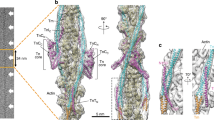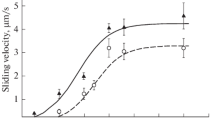Abstract
It is well known that cardiac troponin C (cTnC) regulates the association of force-generating myosin cross-bridges. We report here evidence for an additional role for cTnC. This hypothesis states that Car2+ binds more strongly to cTnC when force-generating myosin cross-bridges are attached to actin and that removal of this bound Ca2+ accelerates the dissociation of force-generating myosin cross-bridges. Intact Fura-2-loaded rat papillary muscles and skinned (permeabilized) ventricular preparations were used. The preparations were mounted in the Guth Muscle Research System which is capable of measuring simultaneously fluorescence and force in response to length perturbations. All mechanical perturbations of muscle length (isotonic shortening, quick stretches and releases, and length vibrations) which cause dissociation of force-generating myosin cross-bridges during a twitch resulted in Ca2+ being released from troponin as judged from changes in the Ca2+ transients (Fura-2 (340/380) fluorescence ratio). Thus dissociation of force-generating myosin cross-bridges cause Ca2+ to be released from cTnC. Conversely, it would be expected that removal of strongly bound Ca2+ from cTnC would result in an increase in the rate of dissociation of force-generating myosin cross-bridges. To test this hypothesis actomyosin ATPase (NADH fluorescence change) and isometric force were measured in skinned cardiac preparations. The ratio of the ATPase/Force is proportional to the rate constant (gapp) for the dissociation of force-generating myosin cross-bridges. The data showed that decreasing the amount of Ca2+ bound to cTnC in skinned cardiac fibers caused an increase in the ratio of ATPase/Force, the rate of dissociation (gapp) of force-generating myosin cross-bridges.
Similar content being viewed by others
References
Allen DG and Kentish JC (1988) Calcium concentration in the myoplasm of skinned ferret ventricular muscle following changes in muscle length. J Physiol 407: 489–503.
Allen DG and Kurihara S (1982) The effect of muscle length on intracellular calcium transients in mammalian cardiac muscle. J Physiol 327: 79–94.
Backx PH and ter Keurs HE (1993) Fluorescent properties of rat cardiac trabeculae microinjected with fura-2 salt. Am J Physiol 264: H1098–H1110.
Bremel RD and Weber A (1972) Cooperation within actin filament in vertebrate skeletal muscle. Nature New Biol 238: 97–101.
Brenner B (1988) Effect of Ca2+ on cross-bridge turnover kinetics in skinned single rabbit psoas fibers: implications for regulation of muscle contraction. Proc Natl Acad Sci USA 85: 3265–3269.
Butters CA, Tobacman JB and Tobacman LS (1997) Cooperative effect of calcium binding to adjacent troponin molecules on the thin filament-myosin subfragment 1 MgATPase rate. J Biol Chem 272: 13196–13202.
Coleman HN (1968) Effect of alterations in shortening and external work on oxygen consumption of cat papillary muscle. Am J Physiol 214: 100–106.
De Tombe PP and Stienen GJM (1995) Protein kinase A does not alter economy of force maintenance in skinned rat cardiac trabeculae. Circ Res 76: 734–741.
Donaldson SKB and Kerrick WGL (1975) Characterization of the effects of Mg2+ on Ca2+-and Sr2+-activated tension generation of skinned skeletal muscle fibers. J Gen Physiol 66: 427–444.
Dotson DG and Putkey JA (1993) Differential recovery of Ca2+ binding activity in mutated EF-hands of cardiac troponin C. J Biol Chem 268: 24067–24073.
Ebashi S and Endo M (1968) Calcium ion and muscle contraction. Prog Biophys Mol Biol 18: 123.
El-Saleh SC, Warber KD and Potter JD (1986) The role of tropomy-osin-troponin in the regulation of skeletal muscle contraction. J Muscle Res Cell Motil 7: 387–404.
Fuchs F (1977) The binding of calcium to glycerinated muscle fibers in rigor. The effect of filament overlap. Biochim Biophys Acta 491: 523–531.
Gibbs CL and Chapman JB (1985) Cardiac mechanics and energetics: chemomechanical transduction in cardiac muscle. Am J Physiol 249: H199–H206.
Gordon AM, Ridgway EB and Martyn DA (1984) Calcium sensitivity is modified by contraction. Adv Exp Med Biol 170: 553–563.
Green LE and Eisenberg E (1980) Cooperative binding of myosin subfragment-1 to the actin-troponin-tropomysion complex. Proc Natl Acad Sci USA 77: 2616–2620.
Griffiths PJ, Guth K, Kuhn HJ and Ruegg JC (1980) ATPase activity in rapidly activated skinned muscle fibres. Pflügers Arch Eur J Physiol 387: 167–173.
Guth K and Wojciechowski R (1986) Perfusion cuvette for the simultaneous measurement of mechanical, optical and energetic parameters of skinned muscle fibres. Pflügers Arch Eur J Physiol 407: 552–557.
Guth K and Potter JD (1987) Effect of rigor and cycling cross-bridges on the structure of troponin C and on the Ca2+ affinity of the Ca2+-specific regulatory sites in skinned rabbit psoas fibers. J Biol Chem 262: 13627–13635.
Hannon JD, Martyn DA and Gordon AM (1992) Effects of cycling and rigor crossbridges on the conformation of cardiac troponin C. Circ Res 71: 984–991.
Hellam DC and Podolsk RJ (1969) Force measurements in skinned muscle fibres. J Physiol (Lond) 200: 807–819.
Hofmann PA and Fuchs F (1987) Effect of length and cross-bridge attachment on Ca2+ binding to cardiac troponin C. Am J Physiol 253: C90–C96.
Housmans PR and Lee NK (1983) Blinks JR Active shortening retards the decline of the intracellular calcium transient in mammalian heart muscle. Science 221: 159–161.
Huxley AF (1957) Muscle structure and theories of contraction. Prog Biophys 7: 255–318.
Kerrick WG, Potter JD and Hoar PE (1991) The apparent rate constant for the dissociation of force-generating myosin cross-bridges from actin decreases during Ca2+ activation of skinned muscle fibres. J Muscle Res Cell Motil 12: 53–60.
Kerrick WG, Zot HG, Hoar PE and Potter JD (1985) Evidence that the Sr2+ activation properties of cardiac troponin C are altered when substituted into skinned skeletal muscle fibers. J Biol Chem 260: 15687–15693.
Kurihara S, Saeki Y, Hongo K, Tanaka E and Sudo N (1990) Effects of length change on intracellular Ca2+ transients in ferret ventricular muscle treated with 2,3-butanedione monoxime (BDM). Jpn J Physiol 40: 915–920.
Kushmerick MJ and Krasner B (1982) Force and ATPase rate in skinned skeletal muscle fibres. Fedn Proc 41: 2232–2237.
Lab MJ, Allen DG and Orchard CH (1984) The effects of shortening on myoplasmic calcium concentration and on the action potential in mammalian ventricular muscle. Circ Res 55: 825–829.
Li HC and Fajer PG (1994) Orientational changes of troponin C associated with thin filament activation. Biochemistry 33: 14324–14332.
Moss RL (1992) Ca2+ regulation of mechanical properties of striated muscle. Mechanistic studies using extraction and replacement of regulatory proteins: a review. Circ Res 70: 865–884.
Palmer S, Di Bello S, Davenport SL and Herzig JW (1996) The novel inotropic agent CGP 48506 alters force primarily by Ca2+-independent mechanisms in porcine skinned trabeculae. Cardiovasc Res 32: 411–421.
Potter JD and Gergely J (1975) The calcium and magnesium binding sites on troponin and their role in the regulation of myofibrillar adenosine triphosphatase. J Biol Chem 250: 4628–4633.
Putkey JA, Liu W, Lin X, Ahmed S, Zhang M, Potter JD and Kerrick WG (1997) Fluorescent probes attached to Cys 35 or Cys 84 in cardiac troponin C are differentially sensitive to Ca(2+)-dependent events in virto and in situ. Biochemistry 36: 970–978.
Sweeney HL and Stull JT (1990) Alteration of cross-bridge kinetics by myosin light chain phosphorylation in rabbit skeletal muscle: implications for regulation of actin-myosin interaction. Proc Natl Acad Sci USA 87: 414–418.
Takashi R and Putnam S (1979) A fluorimetric method for continuously assaying ATPase: application to small specimens of glycerol-extracted muscle fibers. Anal Biochem 92: 375–382.
Tobacman LS (1996) Thin filament-mediated regulation of cardiac contraction. Annu Rev Physiol 58: 447–481.
Vahl CF, Bonz A, Timek T and Hagl S (1994) Intracellular calcium transient of working human myocardium of seven patients transplanted for congestive heart failure. Circ Res 74: 952–958.
Wang YP and Fuchs F(1994) Length, force, and Ca2+-troponinCaffinity in cardiac and slow skeletal muscle. J Physiol 266: C1077–C1082.
Ward CW, Williams JH and Kerrick WGL (1999) Ca2+ activation of force and actomyosin ATPase activity in skinned muscle fibers: effects of [MgATP] and temperature. J Muscle Res Cell Motil, (submitted).
Warren GL, Williams JH, Ward CW, Matoba H, Ingalls CP, Hermann KM and Armstrong RB (1996) Decreased contraction economy in mouse EDL muscle injured by eccentric contractions. J Appl Physiol 81: 2555–2564.
Author information
Authors and Affiliations
Rights and permissions
About this article
Cite this article
Wang, Y., Xu, Y., Guth, K. et al. Troponin C regulates the rate constant for the dissociation of force-generating myosin cross-bridges in cardiac muscle. J Muscle Res Cell Motil 20, 645–653 (1999). https://doi.org/10.1023/A:1005559613516
Issue Date:
DOI: https://doi.org/10.1023/A:1005559613516




